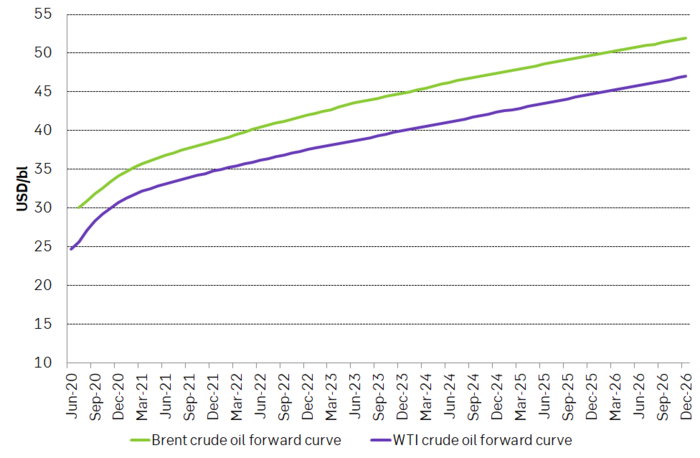Nyheter
Additional cuts is positive for the market and a gift to US/Canada


Additional cuts of 1.2 m bl/d in June from Saudi/Kuwait/UAE yesterday failed to rejoice the oil market and the Brent crude oil price fell 4.3% instead. Today though oil prices are firming a little but the price action (Brent) seems to be centered around the $30/bl mark right now. A depressing thought for OPEC+ must be that side-lined production in the magnitude of 3.5 – 4.5 m bl/d in the US/Canada will be the first to reap the rewards of the production cuts by OPEC+.

The Brent crude July contract yesterday moved to an intraday high of $31.47/bl (+1.6%) on the announcement that Saudi Arabia will cut an additional 1 m bl/d in June with Kuwait and UAE also chipping in additional cuts of about 100 k bl/d each. The joy didn’t last and in the end the contract fell back 4.3% on the day to a close of $29.63/bl along with negative equities and concerns over renewed virus outbreaks.
This morning Brent is inching 1.7% higher to $30.1/bl with the June WTI contract a little bit feistier gaining 2.7% to $24.8/bl. Overall market sentiment is on the negative side with lower equities and metals so oil is mostly going up on its own today. Market is obviously far from certain that the additional cuts announced yesterday will be able to drive the oil price materially higher but is today the conclusion that yes, the additional cuts are naturally positive on the margin.
The announcement yesterday was that Saudi/Kuwait/UAE will together make an additional 1.2 m bl/d cut in June versus already pledge cuts with Saudi cutting 1 m bl/d more to 7.5 m bl/d, Kuwait 0.08 m bl/d to 2.1 m bl/d and UAE 0.1 m bl/d to 2.35 m bl/d. Political pressure from the US, strained state finances in Saudi/Kuwait/UAE and a wish to re-balance the oil market and revive oil prices as quickly as possible lay behind the announcement.
It is very difficult to cut production with good results if you haven’t got a tailwind of strengthening oil demand to help you. The demand part of the equation is still a big uncertainty. Oil demand is now naturally coming back from the abyss in March/April as we get gradual reopening. But these re-openings look like they will be riddled with start/stop issues as virus infections blossom up again. How fast and how far back towards normal demand we can get is today the biggest uncertainty and a key ingredient for OPEC+ success. But demand will of course rebound both back to 100 m bl/d and beyond eventually. The key question now is how much and how fast.
But deepening production cuts now is also tricky for OPEC+. If they are successful in balancing the market, flattening the crude oil price curve and thus drive the front-month crude oil price higher then this will likely very quickly revive the 3.5 – 4.5 m bl/d of side-lined supply in the US & Canada. Thus, all Saudi/Kuwait/UAE will have achieved by cutting an additional 1.2 m bl/d is to let side-lined production in the US & Canada back into the market. Again, without being able to drive the oil price much higher.
This poses a key question: Who shall be first out to put volumes back into the market as demand revives? Side-lined US & Canadian oil wells or OPEC+ production cuts? Right now, it looks like OPEC+ or at least Saudi/Kuwait/UAE are following a strategy where shut-in production outside of OPEC+ are to be placed back in the market first.
Then on to the next step. Will OPEC+ then hold on to production cuts in order to opt for price rather than volume once the oil price moves back to $50/bl thus once again chase the oil price to $60/bl and $70/bl by holding back supply? If so, this would again give preference to shale oil volume rebound in exchange for a higher oil price to OPEC+. Such a next step looks much less likely because Russia made it very clear in March that they are basically done chasing price in exchange for gradual loss of market share to OPEC+ and more market share to US shale oil.
It is hard to conclude otherwise than that the global oil market is gradually mending with rebounding demand on the one hand and cuts to production, lost supply or shut in supply on the other.
But a sense of futility must clearly be felt by Saudi/Kuwait/UAE the moment in time when 3.5 – 4.5 m bl/d of side-lined production in the US/Canada are placed back into the market in response to their deepening production cuts. Because that is likely now what is going to happen as they ”succeed” with their cuts.
Forward crude oil curves for Brent and WTI. As the oil market starts to balance and inventories starts to draw down the front-end of these curves will move higher and the curves will flatten. This will help to revive side-lined production in the US/Canada in the magnitude of 3.5 – 4.5 m bl/d.

Nyheter
Sommarvädret styr elpriset i Sverige

Många verksamheter tar nu ett sommaruppehåll och ute värmer solen, det är gott om vatten och vinden blåser. Lägre efterfrågan på el och goda förutsättningar för kraftproduktionen höll ner elpriserna under juni.

Elpriset på den nordiska elbörsen Nord Pool (utan påslag och exklusive moms) i elområde 1 och 2 (Norra Sverige) blev för juni 3,05 respektive 4,99 öre/kWh, vilket är rekordlågt och de lägsta på minst 25 år.
– Elpriset påverkas av en rad faktorer men vädret väger tyngst. På sommaren minskar efterfrågan på el och många verksamheter har ett uppehåll. Detta tillsammans med goda förutsättningar inom kraftproduktionen påverkar elpriset nedåt, säger Jonas Stenbeck, privatkundschef Vattenfall Försäljning Norden.
Den hydrologiska balansen, måttet för att uppskatta hur mycket vatten som finns lagrat ovanför kraftstationerna, ligger över normal nivå, särskilt i norra Skandinavien. Tillgängligheten för kärnkraften i Norden är just nu 82 procent av installerad effekt.
– De goda nordiska produktionsförutsättningarna gör elpriserna mindre känsliga för förändringar i omvärlden, säger Jonas Stenbeck.
Priserna på olja och gas kan dock ändras snabbt med anledning av en turbulent omvärld. På kontinenten har efterfrågan på gas sjunkit och nytt solkraftsrekord för Tyskland sattes på midsommarafton med en produktion på 52,5 GW.
– Många av de goda elvanor vi skaffade oss under elpriskrisen verkar leva kvar och gör nytta även på sommaren. De svenska hushållens elförbrukning under 2024 var faktiskt den lägsta detta millenium, säger Jonas Stenbeck.
| Medelspotpris | Juni 2024 | Juni 2025 |
| Elområde 1, Norra Sverige | 24,04 öre/kWh | 3,05 öre/kWh |
| Elområde 2, Norra Mellansverige | 24,04 öre/kWh | 4,99 öre/kWh |
| Elområde 3, Södra Mellansverige | 27,27 öre/kWh | 22,79 öre/kWh |
| Elområde 4, Södra Sverige | 62,70 öre/kWh | 40,70 öre/kWh |
Nyheter
Samtal om flera delar av råvarumarknaden

Ett samtal som sammanfattar ett relativt stabilt halvår på råvarumarknaden trots volatilitet och geopolitiska spänningar som sannolikt fortsätter in i andra halvan av året. Vi bjuds även på kommentarer från Carlos Mera, Rabobanks analyschef för jordbrukssektorn och Kari Kangas, skogsanalytiker.
Nyheter
Jonas Lindvall är tillbaka med ett nytt oljebolag, Perthro, som ska börsnoteras

Jonas Lindvall, ett välkänt namn i den svenska olje- och gasindustrin, är tillbaka med ett nytt företag – Perthro AB – som nu förbereds för notering i Stockholm. Med över 35 års erfarenhet från bolag som Lundin Oil, Shell och Talisman Energy, och som medgrundare till energibolag som Tethys Oil och Maha Energy, är Lindvall redo att än en gång bygga ett bolag från grunden.
Tillsammans med Andres Modarelli har han startat Perthro med ambitionen att bli en långsiktigt hållbar och kostnadseffektiv producent inom upstream-sektorn – alltså själva oljeutvinningen. Deras timing är strategisk. Med ett inflationsjusterat oljepris som enligt Lindvall är lägre än på 1970-talet, men med fortsatt växande efterfrågan globalt, ser de stora möjligheter att förvärva tillgångar till attraktiva priser.
Perthro har redan säkrat bevisade oljereserver i Alberta, Kanada – en region med rik oljehistoria. Bolaget tittar även på ytterligare projekt i Oman och Brasilien, där Lindvall har tidigare erfarenhet. Enligt honom är marknadsförutsättningarna idealiska: världens efterfrågan på olja ökar, medan utbudet inte hänger med. Produktionen från befintliga oljefält minskar med cirka fem procent per år, samtidigt som de största oljebolagen har svårt att ersätta de reserver som produceras.
”Det här skapar en öppning för nya aktörer som kan agera snabbare, tänka långsiktigt och agera med kapitaldisciplin”, säger Lindvall.
Perthro vill fylla det växande gapet på marknaden – med fokus på hållbar tillväxt, hög avkastning och effektiv produktion. Med Lindvalls meritlista och branschkunskap hoppas bolaget nu kunna bli nästa svenska oljebolag att sätta avtryck på världskartan – och på börsen.
-

 Nyheter3 veckor sedan
Nyheter3 veckor sedanStor uppsida i Lappland Guldprospekterings aktie enligt analys
-

 Nyheter4 veckor sedan
Nyheter4 veckor sedanBrookfield ska bygga ett AI-datacenter på hela 750 MW i Strängnäs
-

 Nyheter3 veckor sedan
Nyheter3 veckor sedanSilverpriset släpar efter guldets utveckling, har mer uppsida
-

 Nyheter4 veckor sedan
Nyheter4 veckor sedanTradingfirman XTX Markets bygger datacenter i finska Kajana för 1 miljard euro
-

 Nyheter2 veckor sedan
Nyheter2 veckor sedanUppgången i oljepriset planade ut under helgen
-

 Nyheter2 veckor sedan
Nyheter2 veckor sedanLåga elpriser i sommar – men mellersta Sverige får en ökning
-

 Analys2 veckor sedan
Analys2 veckor sedanVery relaxed at USD 75/b. Risk barometer will likely fluctuate to higher levels with Brent into the 80ies or higher coming 2-3 weeks
-

 Nyheter1 vecka sedan
Nyheter1 vecka sedanMahvie Minerals växlar spår – satsar fullt ut på guld









